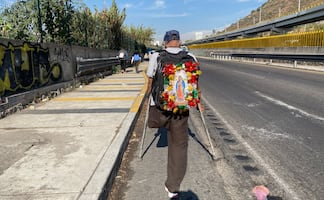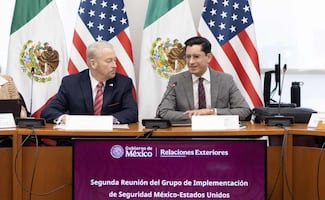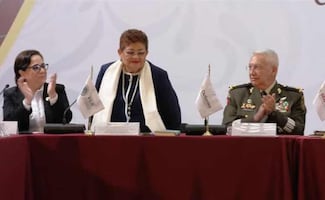Más Información

Fe que desafía límites en la México-Puebla; miles caminan hacia La Villa entre devoción, mandas y agradecimientos

Corte avala que mujeres musulmanas puedan obtener pasaporte sin quitarse hiyab en toma de foto; reconoce “libertad religiosa”

Buque petrolero será llevado a puerto de EU; Venezuela tacha de "robo" flagrante y un acto de "piratería internacional"
The Education Reform enacted by the administration of Enrique Peña Nieto represented a public expense of at least 81.5 billion pesos for the implementation of several programs meant to put it into action, as well as the financing of state advertising to “inform the Mexican people of its benefits.” Another considerable amount was given to the National Education Workers Union (SNTE) to promote said public policy among teachers.
The president-elect Andrés Manuel López Obrador has announced that, as soon as he takes office, said reform will be repealed, with all that this would imply.
The amount spent on the Education Reform would be enough to build four subway lines in Mexico City ; it would also be enough to finance two institutions with the size of Mexico’s National Autonomous University (UNAM) for an entire year, or to rebuild, remodel, and repair 25% of all 200 thousand public schools in the country . Experts agree that there were “excessive” and “abusive” expenses, and that all the resources used on state advertising were money down the drain.
On the White Paper of the Education Reform, which was considered to be the most important structural change made during the present administration, the Ministry of Public Education (SEP) listed at least 13 programs created by the government of Enrique Peña Nieto to put the reform into action .
These programs represented an investment of 72.45 billion pesos . Said investment was meant to finance the National Program of School Coexistence, the Design of the Education Policy, the official Education Reform Program, the Professional Development Program for Teachers, and the Program to Strengthen the Quality of Basic Education .
A considerable amount was also channeled to education centers, organizations, the production and distribution of textbooks and education materials, which were distributed as part of the new education model; the National English Language Program; the Program for Inclusion and Equity; Production and Transmission of Education Materials, and the Administration Reform undertaken by the institution.
For instance, the federal government spent more than five billion pesos on the purchase and delivery of computers, tablets, and technology classrooms in school communities. Said initiatives were canceled at the midpoint of Peña Nieto’s six-year period.
Francisco Urrutia de la Torre, an investigator from the ITESO University in Guadalajara
, considered that the “most serious problem” regarding education investment was that the present administration decided to spend more resources on the evaluation of teachers than on their professional training.
“Its as if someone wanted to lose weight by spending five times more on buying the right scale than on going to the gym. It was counterproductive: In order to improve education, the first thing you should do is provide training for your teachers and undertake certain evaluation actions,” he commented.
In the opinion of Ángel Díaz Barriga, an investigator from the National Autonomous University of Mexico (UNAM) , all the resources spent on propaganda and the dissemination of advertisements on the so-called benefits of the reform were also “a complete waste of money.”
Furthermore, he considered that there had been an enormous waste of resources in the teachers training program, since the resources paid by the SEP did not correspond with the teachers’ updating needs. Instead, millions were spent on the purchase of tablets and computers for a program that was canceled halfway through the six-year term.
“It was outrageous to have spent so much money on publicity when the National Human Rights Commission claimed that at 42% of public schools in the country lacked a sewage disposal system . Strong efforts were made to convince the Mexican society with a conservative discourse for the detriment of teachers in public schools […] We need to tie the hands of politicians,” he concluded.
According to transparency reports delivered by the SEP and the National Institute of Access to Public Information (INAI) , a total of 5.8 billion pesos were spent on advertising contracts with media outlets with the purpose of informing on the “benefits” of the education reform.
Money for the SNTE
During Juan Díaz de la Torre ’s administration as head of the National Education Workers Union, the unionized teachers received a total of 3.13 billion pesos throughout the six-year term to promote the education reform.
According to information obtained through the transparency website of the SNTE and the OPTISNTE, said resources were agreed upon through annual contracts signed by the SEP and the workers union, through which the federal body handed out money for the promotion of the education reform undertaken by the administration of Enrique Peña Nieto. The union even used part of the funding to create its very own philharmonic orchestra .
A total of 1.5 billion pesos was given to the union between the years 2013 and 2018
to spend on the promotion of the education reform. Another 800 million pesos were spent on social welfare benefits, cultural promotion, and actualization programs .
Another 500 million pesos were given to the SNTE for the National Program for the Support of the Education Reform, and another 500 million for the National Program for the Support of the New Education Model.
dm
Noticias según tus intereses
[Publicidad]
[Publicidad]












